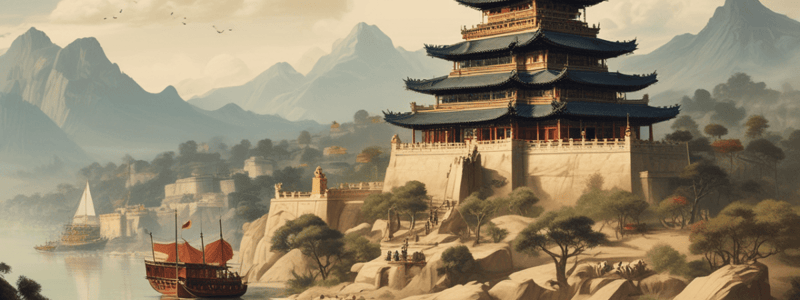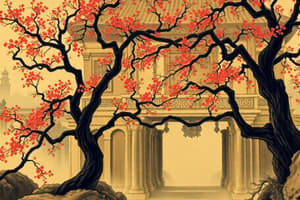Podcast
Questions and Answers
What defines the start and end of a dynasty?
What defines the start and end of a dynasty?
- The birth and death of a particular ruler
- The replacement of one ruling family by another (correct)
- The rise and fall of a particular empire
- The change in the capital city of the empire
Why did the Tang seek to emulate the Han Dynasty?
Why did the Tang seek to emulate the Han Dynasty?
- To follow the Han's economic and administrative systems (correct)
- To restore the unity of China after the fall of the Sui
- To establish a new capital city
- To send a message of power and strength to neighboring countries
What was life like in the Sui Dynasty?
What was life like in the Sui Dynasty?
- It was a period of constant warfare and instability
- It was a period of relative peace and economic prosperity (correct)
- It was a period of significant territorial expansion
- It was a period of cultural and artistic stagnation
Why did the Sui Dynasty come to an end?
Why did the Sui Dynasty come to an end?
What can we learn about a culture from the fact that they organize their history in terms of dynasties?
What can we learn about a culture from the fact that they organize their history in terms of dynasties?
What was a notable feature of the Tang Dynasty?
What was a notable feature of the Tang Dynasty?
What was the purpose of the Three Dynasties Activity?
What was the purpose of the Three Dynasties Activity?
What was the extension activity for the lesson?
What was the extension activity for the lesson?
What was the significance of the Mongol invasion on China?
What was the significance of the Mongol invasion on China?
Flashcards are hidden until you start studying
Study Notes
Lesson Overview
- The lesson focuses on the Sui, Tang, and Song dynasties of China, covering their importance, characteristics, and contributions to Chinese history.
Understanding Dynasties
- A dynasty is a series of rulers from the same family or group.
- The start and end of a dynasty are defined by significant events, such as the overthrow of a previous ruler or the establishment of a new government.
- People justify overthrowing a dynasty and starting a new one by citing reasons such as corruption, mismanagement, or the need for change.
Sui Dynasty
- The Sui Dynasty restored unity to China after the fall of the Han Dynasty.
- They reestablished control of China by rebuilding infrastructure, reforming the government, and promoting Buddhism.
- Life in the Sui Dynasty was marked by significant cultural and economic achievements.
- The Sui Dynasty came to an end due to internal conflicts, corruption, and external pressures.
Tang Dynasty
- The Tang Dynasty sought to emulate the Han Dynasty, aiming to recreate its success and grandeur.
- They hoped to send a message of stability and prosperity by emulating the Han.
- Life under the Tang Dynasty was marked by significant cultural, economic, and technological advancements.
- Chinese civilization changed during this time period, with the development of new technologies, trade, and cultural exchange.
Song Dynasty
- The Song Dynasty was marked by significant cultural, economic, and technological advancements, building on the achievements of the Tang Dynasty.
- The Song Dynasty was characterized by a focus on education, literature, and the arts.
- The Song Dynasty came to an end with the Mongol invasion, which had a significant impact on China.
Importance of Dynasties
- The difficulty of maintaining a unified state in ancient China reveals the complexity and diversity of Chinese history.
- Ancient Chinese people did not always identify as a single, unified Chinese identity.
- The study of dynasties provides insights into Chinese culture, politics, and society.
Studying That Suits You
Use AI to generate personalized quizzes and flashcards to suit your learning preferences.




